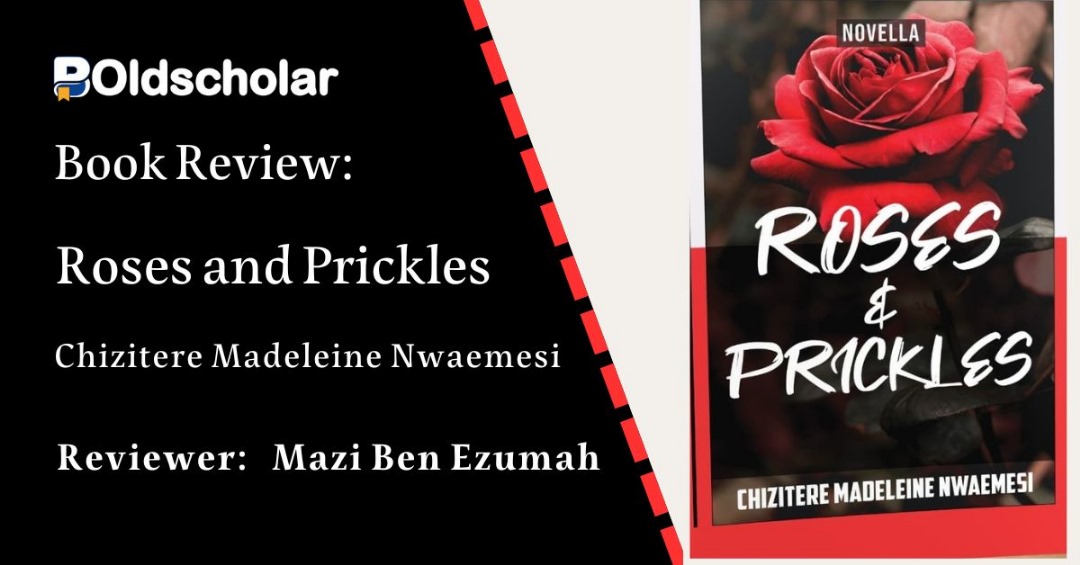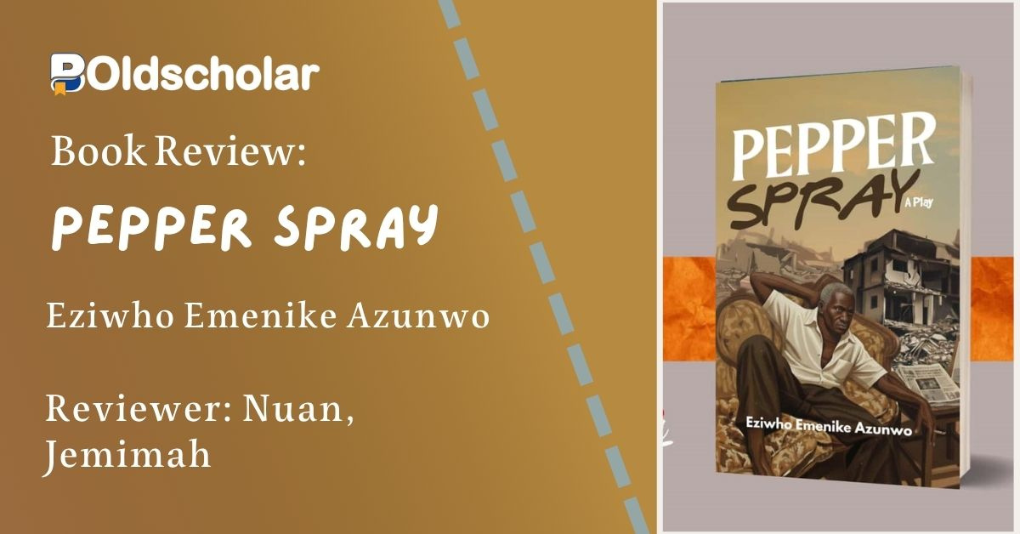Title: Roses and Prickles
Author: Chizitere Madeleine Nwaemesi
Pages: 100
Publisher: Libretto Publishers Limited, Oyo, Oyo state.
Book Reviewer: Mazi Ben Ezumah
Date of Publication: 2024
Chizitere Madeleine Nwaemesi’s novella is a heartrending tragedy interspersed by multiple love stories; which are blighted, in some ways, by vagaries of life ranging from distance, separation, fear, marital infidelity, grief, bereavement, pain, mistrust, career pursuit, disillusionment, death, hope for the future and so on. Chizitere Madeleine Nwaemesi’s novella, Roses & Prickles addresses the human condition: love, pain, pleasure, suffering, distrust, hope, aspiration, morality, immorality, conflict, despair, anguish, disease, and death. Issues bordering on human condition have always fascinated writers down the ages: We see them in Greek Mythology-Homer’s Sisyphus, in the IIiad, Sophocles’ Oedipus Rex, Shakespeare’s King Lear, Albert Camus’s The Rebel, Dostoevsky’s Brothers Karamazov and several others. Human suffering whether fruitless or fruitful is both destructive and redemptive. Suffering defines and strengthens the quality of characters in a story. It underscores their humanity, simplicity or complexity as the case may be.
The theme of love is well developed in the story, as it manifests in various forms: The love between Roselyn and her mother is mutual, beautiful and healthy. We see the mother giving quality advice as a mother and supporting her in difficult situations. Unlike her father who is hardly seen or heard. The love between Roselyn and Henry is unhealthy, as it crosses social and traditional boundaries. A relationship between cousins is disallowed in many societies for reasons bordering on inbreeding complications and so on. This sometimes happens when parents lead very busy lives or are absentee parents, and minors are left on their own for lengthy periods of time. The marital love is observed between Roselyn’s parents who live apart, one in Abuja and the other, in Kaduna. However, they meet once a year for their summer vacation. Soon, they eventually drifted farther apart until they finally divorced. Jidenna and Roselyn also enjoy marital love which is hampered by sickle cell disease suffered by their children. Human suffering most times blights or taints even the best of human spirit, and we see how that beautiful love between them is disfigured by the suffering of their children and eventually their deaths. Both Roselyn and Jidenna are rudely dealt with by those tragedies, and they never really recovered from them as separation, infidelity and divorce help hammer in the final nail on the coffin of a beautiful relationship that started so well. The love between Rose and Nnamdi is worth mentioning because he is a next door neighbour whom Rose has always observed from the balcony of her parents’ house across the street. They grow up together as children, and apart from a few encounters, the reader is not sure there is much between them until Nnamdi’s lovely confession and proposal towards the end of the story. It is also on the strength of that proposal that the reader believes the mystery groom that Roselyn dresses up to meet in the “Vestibule of the Marriage Registry” as the story ends is Nnamdi. Love stories and relationships are the roses in the story.
Disease and Death: These are the “Prickles” in the story. The sickle cell disease is a major plank on which the story by Chizitere Madeleine Nwaemesi rests: Nwabuko & et al (2022, p.1) asserts that, “About 50 million people are living with SCD globally and Nigeria is the epicentre zone with about 4-5 million people living with the disease (1 in every 4 Nigerians has a sickle cell trait). Annually, about 300,000 newly diagnosed SCD children are born world-wide…” Just as the character, Roselyn, out of desperation or self-examination asked herself some basic questions that, perhaps ought to have been asked at the commencement of her marriage and births of her children: “Is it worth it?” “Are all these hospital trips, death, and anxiety worth it? What was it all about? Love? Sex? These are the kind of questions a reasonable individual that is a carrier of the AS or SS gene should ask themselves as they make their life defining choices especially when procreation is involved. Why bear children, if you know their very existence could be blighted by and/or be predisposed to debilitating disease, immense suffering and death?
Why marry if it only leads to untold hardship, heartaches as seen in the relationship between Jidenna and Roselyn? Natural laws are oftentimes unforgiving in their application. If one takes leave of one’s senses and jumps off a high rise building; the outcome is always the same ruddy mess across the lawns or landscape. The law of gravitation is constant on Earth. If one is born with the AS sickle cell trait or SS sickle cell anaemia gene that remains a constant factor till the end of life of that individual. Drugs, prayer, fasting, and so on, merely offer psycho-social-therapeutic relief as nothing else changes or alters the underlying fact of the existence of Sickle cell trait in one’s genetic constitution as it is inscribed in the person’s DNA. Therefore, it is expected that people living with such issues should arm themselves with relevant knowledge and behave wisely, so as to avoid the type of experiences Roselyn and Jidenna went through in their marriage and family. That is the core message, and principal concern of the author of the novella, Roses and Prickles. Living in denial of the fact of Science or acting in damnable ignorance cannot expunge the collateral consequences of Sickle Cell Disease in an individual.
The linear and non-linear plot methods are masterfully used in telling the story: The first chapter of the story starts as we see the main character dressed up, seated in a car and ready for the next phase of her life. That action is paused to admit all the other actions in the story, and we do not see the character gain in her wedding dress till the last chapter. The introduction or exposition is used as we see five-six year old children at the beginning of the story. As the story progresses the children go to college and travel, mature into young adults and eventually thrive as adults. The climax of the story is attained around the middle of the story as its anti-climax and denouement, (catastrophe or resolution) are achieved towards its fitting conclusion.
The author has good command of the English language and uses it so richly in the expression and/or communication of her thoughts. The use of language is elevated in some contexts and simple in others. Human language is natural and spoken or written within different contexts that are dynamic. The author understands this phenomenon well and uses her proficiency in the language to a great advantage. She consciously chooses her words in order to achieve the desired effects in the mind of the reader. During the heart-wrenching scene of the death of Roselyn’s son, Kachi, that by the way, could rightly be assessed as the climax of the story; such atmosphere of suspense is created, and strong feelings of anxiety, apprehension, empathy, sadness, and so on are adroitly invoked in the reader to reflect the tense situation the characters found themselves in. Also, the author’s effective or picturesque use of language can be observed on page 5, where she tries to describe Nnamdi’s voice thus: “His voice tasted like Naija jollof blessed with aromatic spices and chunks of well-seasoned goat meat dipped in a hot sauce of British accent, served fresh out of the grill.”
Chizitere Madeleine Nwaemesi’s narrative technique is remarkably different from how most writers write. Most writers use either the Third Person Omniscient narrative technique or the First Person narrative technique. The author uses the second person narrative, which, I know, is rare and difficult to execute or sustain in prose writings such as short story, novella or novel of this nature. In this style of writing, the author uses what appears to be an apostrophic, invocative or introspective style of narrative. Examples of this style of writing are all over the book: “You turned off the water heater and turned on the tap. You scrubbed your skin furiously, hoping to scrub off the dirt of death that had settled on your pores at the club. One time ago, you read something about death somewhere. In the excerpt, they illustrated how contagious death could be…”p.49. It takes experience and skilful mastery of the language to write in this fashion. In the use of the second person narrative technique, the narrative is spontaneously impersonalised by the speaker or character himself even when the character talks about himself or herself. I must commend the writer, Chizitere Madeleine Nwaemesi for raising the bar a notch higher; and taking the more difficult, less used style, even though this is her first major publication.
In spite of the few misprints and errors of rendering in the book, the author has done excellently well in communicating her thoughts and presenting those thoughts in a beautiful style that conveys relevant information that helps the society, which due to the inherent contradictions in it, many even in the resplendent light of the 21st century still wallow in the darkness and the ignorance which lack or poor use of available information inflicts on the human mind inexorably crippling it as a result. Thus, ignorance, even among some educated people, has its consequences.
Share this post





Prof Austine Amanze Akpuda
This is a very engaging review that reminds one so much of the language of (another?) Ben Ezuma whose very impactful literature commentaries (in pamphlets) I read in the period between 1979 and 1981.